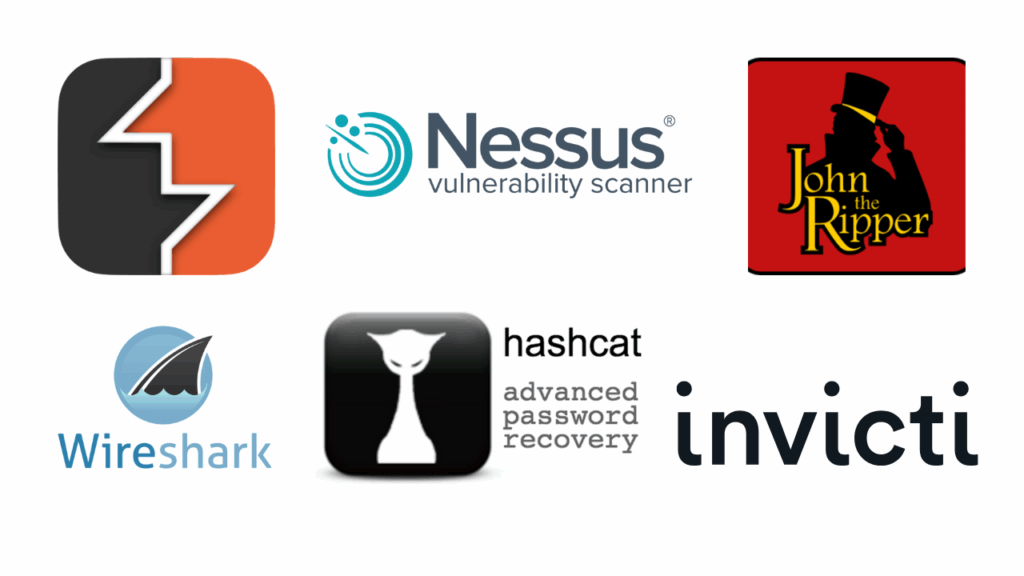Selecting the right penetration testing tools is crucial for securing your network, applications, and systems. The right tools help uncover vulnerabilities before attackers do, ensuring your organization stays protected.
This guide explores top-rated security testing tools, their strengths, and how they fit different security needs.
So, want to know which tool can uncover critical flaws in your system or network? We cover top tools, highlighting key features, strengths, and use cases.
Read further for expert insights and a one-of-a-kind breakdown of essential tools.
What are Pentesting Tools?

Pentesting tools are software used in penetration testing (or pentesting), a critical process in cybersecurity to assess and strengthen security. These tools help pentesters identify, exploit, and report vulnerabilities in a system or network.
During penetration testing, these tools perform tasks like vulnerability scanning, reconnaissance, and exploitation to identify weaknesses.
Pentesting tools assist in testing application security, network security, and detecting misconfiguration. They support remediation efforts and ensure your systems remain secure.
Why is Security Penetration Testing Important?

Security penetration testing is important because it helps organizations find and fix potential vulnerabilities before attackers exploit them.
As a result, it provides a proactive defense for any target system or network.
Moreover, it strengthens an organization’s security posture by identifying vulnerabilities before attackers can exploit them. A comprehensive study on penetration testing frameworks highlights how different tools and methodologies contribute to security testing effectiveness, ensuring compliance with industry standards like HIPAA and NIST.
In addition, it supports fixing vulnerabilities by providing actionable insights on exploitable vulnerabilities. This support improves security through immediate remediation.
Penetration Testing Process

Plan
The first step is setting clear goals and defining the scope of the test. Testers gather important information about the target system or network, identify possible attack vectors, and choose the best testing techniques.
This phase helps create a structured approach without disrupting operations.
Scan
Next, testers look for weaknesses by scanning for open ports, services, and known vulnerabilities. Both automated and manual penetration testing tools help map out security gaps, giving a clear picture of potential entry points.
Gain Access
This is where testers try to break in. They exploit security issues using real-world attacks like XSS, API flaws, and initial access techniques. The goal is to see how deep an attacker could go if they found a way in.
Maintain Access
Once inside, testers check if they can stay undetected. They analyze network traffic, communication channels, and privilege escalation methods to understand how an attacker could maintain control over time.
Analyze
The final step is reviewing everything. Testers document exploitable vulnerabilities, provide remediation steps, and compare results with compliance requirements. This helps organizations strengthen security and prevent real threats.
Types of Penetration Testing

Web Application Penetration Testing
Web applications handle sensitive data, making them prime targets for attacks. This type of testing evaluates web application security before hackers exploit them.
Testers analyze databases, authentication mechanisms, and backend systems to find weaknesses.
For instance, a tester might discover a SQL injection flaw in an e-commerce platform that allows unauthorized access to customer data.
The process involves:
- Reconnaissance
- Vulnerability identification
- Exploitation
- Reporting
The result? A detailed report highlighting exploitable vulnerabilities and remediation steps.
Network Services Penetration Testing
This test examines network devices, servers, and firewalls for known vulnerabilities and misconfigurations that could lead to breaches.
Testers focus on internal and external networks, using scanning, enumeration, exploitation, and privilege escalation to assess the weakest points.
For example, a tester may exploit an outdated SSH service to gain unauthorized network access.
By the end, security teams gain insights into attack vectors and receive clear steps to fix vulnerabilities before they become real threats.
Physical Penetration Testing
This test evaluates how well an organization protects its restricted areas, data centers, and offices from unauthorized access.
Testers attempt to bypass security using techniques like tailgating, lock picking, and badge cloning.
For example, a tester might clone a security badge to enter a restricted server room undetected.
The process includes planning, surveillance, entry attempts, and documentation.
If a tester successfully gains access, it reveals how an attacker could breach a facility and compromise systems.
Client Side Penetration Testing
Client-side pentesting focuses on a client device’s desktop applications, browsers, and plugins.
Testers examine code, permissions, and interactions to find weaknesses.
For example, a tester may uncover a browser vulnerability that allows attackers to steal session cookies, leading to account takeovers.
The findings help organizations secure end-user systems and prevent data theft.
Social Engineering Penetration Testing
A strong firewall won’t help if an employee unknowingly hands over their credentials. Thus, social engineering pentesting evaluates how well staff can resist social engineering attacks, such as phishing, pretexting, and impersonation.
The process includes testers using deception to manipulate employees into revealing sensitive information. For instance, a tester might send a convincing phishing email, tricking an employee into giving away login details.
Mobile Application Penetration Testing
Mobile apps handle sensitive data, making them a common target for cyberattacks. This testing finds security flaws in Android and iOS applications before attackers exploit them.
The goal is to identify weaknesses in app code, authentication, and backend systems to improve security. A tester might find weak encryption in a banking app, exposing financial data to attackers.
6 Best Penetration Testing Tools

We have compiled the best penetration testing tools on the market today for you. Check out this comparison table:
| Tool | Purpose | Key Features | Unique Feature | Compatibility |
| Burp Suite | Web security testing | Proxy Intercept, API Scanning, Burp Intruder, Automated Logging | Extensibility via BApp Store | Windows, macOS, Linux |
| Nessus | Vulnerability assessment | Unlimited scans, Risk scoring, Compliance audits, Cloud scanning, Automated reporting | Six-sigma accuracy with the lowest false positives | Windows, macOS, Linux |
| John the Ripper | Password cracking | Supports multiple hash types, Custom wordlists, Parallel processing, Cracks encrypted files | Jumbo version expands encryption support | Windows, macOS, Linux |
| Wireshark | Network traffic analysis | Deep protocol inspection, Live capture, Advanced filtering, Decryption support | VoIP traffic analysis for voice communication | Windows, macOS, Linux, BSD |
| Hashcat | High-speed password recovery | Multi-platform, Multi-hash cracking, Custom attack modes, Distributed processing, Auto-tuning | In-kernel rule engine for real-time cracking | Windows, macOS, Linux |
| Invicti | Web vulnerability scanning | Automated scalable scanning, False positive elimination, DevOps integrations, Compliance reports | Proof-based scanning for verified vulnerabilities | Windows, Linux (via Docker) |
1. Burp Suite
Burp Suite, developed by PortSwigger, is a powerful tool for web security testing. It conducts a man-in-the-middle attack between a browser and a web server while balancing manual and automated testing.
Some of its key features include:
- Proxy Intercept View: Captures and modifies web traffic for testing.
- Authenticated API Scanning: Finds vulnerabilities in APIs, ensuring security.
- Burp Intruder: Automates attack patterns to test authentication and data validation.
- Automated Logging: Centralizes findings for easy reporting and remediation.
What makes Burp Suite unique is its extensibility. With over 10 years of custom extension support, users can add functionalities through the BApp Store or create their own tools.
2. Nessus
Nessus is developed by Tenable, an exposure management company. It automates scans to identify known vulnerabilities, missing patches, and security weaknesses. It also provides risk scoring, helping prioritize remediation efforts.
Here are their key features:
- Unlimited vulnerability assessments to scan IT environments.
- Vulnerability scoring with CVSS v4, EPSS, and Tenable’s VPR.
- Configuration, compliance, and security audits to maintain industry standards.
- Web application and cloud infrastructure scanning for complete coverage.
- Automated reporting to simplify security documentation.
Nessus ranks at the top with its extremely low false-positive rate, achieving six-sigma accuracy (0.32 defects per 1 million scans).
3. John the Ripper
This tool is an open-source tool that helps security professionals find weak passwords across different systems before attackers do.
It cracks weak passwords using dictionary attacks, brute-force methods, and precomputed hashes across operating systems, web apps, and encrypted files.
Here are the promising features:
- Support for hundreds of hash types, including Unix, Windows, and web applications.
- Customizable wordlists and mangling rules for advanced password cracking.
- Parallel and distributed processing to speed up attacks.
- Ability to crack encrypted files, including ZIP, RAR, PDF, and cryptocurrency wallets.
The Jumbo version expands its capabilities even further, supporting a broader range of encryption types and password formats.
4. Wireshark
This is a network protocol analyzer that provides deep visibility into network traffic. It captures and inspects data packets in real-time and allows offline analysis for detailed troubleshooting.
Some of its most useful capabilities include:
- Deep protocol inspection for analyzing hundreds of network protocols, with frequent updates.
- Live capture and offline analysis for flexible troubleshooting.
- Advanced filtering and coloring rules to quickly identify anomalies.
- Decryption support for protocols like SSL/TLS, IPsec, and WPA2.
- Multi-platform compatibility, running on Windows, macOS, Linux, and more.
There’s one interesting feature: VoIP traffic analysis. It provides detailed insights into voice communications.
5. Hashcat
Hashcat is a high-speed password-cracking tool used by security professionals to test password strength and recover lost credentials. It supports CPU, GPU, and other hardware accelerations, making it one of the fastest tools available.
Some features include:
- Multi-Platform Support: Runs on Windows, Linux, and macOS.
- Multi-Hash Cracking: Processes multiple hashes simultaneously.
- Customizable Attack Modes: Supports brute-force, dictionary, hybrid, and rule-based attacks.
- Distributed Cracking: Uses multiple devices for increased speed.
- Automatic Performance Tuning: Optimizes speed for different hardware setups.
What amazes us is Hashcat’s in-kernel rule engine, which generates password candidates in real-time on the GPU or CPU, boosting performance far beyond traditional penetration testing tools.
6. Invicti
Formerly known as Netsparker, Invicti scans web applications and APIs, identifies security flaws like SQL injection and XSS, and integrates them with development workflows for seamless remediation.
Some of its standout features include:
- Scalable, automated scanning for thousands of web assets.
- False positive elimination using proof-based scanning technology.
- Integration with 50+ platforms like Jira, GitHub, and Jenkins.
- Detailed compliance reporting for security audits.
A unique feature of Invicti is its proof-based scanning, which automatically verifies vulnerabilities to reduce false positives.
Frequently Asked Questions
Is Nmap easily detectable?
Yes, Nmap scans can be detected by firewalls and intrusion detection systems, especially when using aggressive modes. However, stealth techniques like slow scans, decoy scans, and fragmentation can help reduce the chances of detection.
Is it considered illegal to scan a website for vulnerabilities?
Yes, scanning a website without permission is often illegal and may be considered unauthorized access or hacking attempts. Always get explicit approval from the website owner before performing any security tests.
Does penetration testing require coding?
Coding isn’t always necessary, but it’s highly beneficial as it makes pentesting more efficient. Knowing languages like Python, Bash, or PowerShell helps with automation, exploit creation and vulnerability analysis.
Conclusion
Choosing the right penetration testing tools is important for identifying vulnerabilities and securing your systems. Each tool serves a unique purpose in strengthening cybersecurity defenses.
At Fluxgate, we help businesses stay ahead of cyber threats with expert insights and customized security solutions. Ready to strengthen your defenses? Contact us today!
